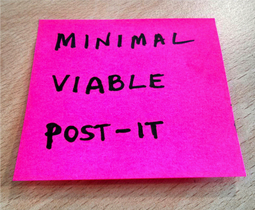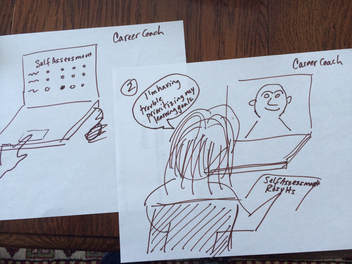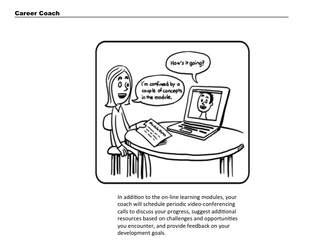Mission: Impact podcast & blog
Build a better world without becoming a martyr to your nonprofit cause
Listen on:
|
I did a workshop recently for a group of nonprofit professionals on one of the most useful research tools in the design thinking tool kit – the customer journey map. Customer may need to be translated for nonprofits. For associations it could be mapping the member and nonmember experience. Or those you serve and support. Or customer could be swapped for partner organization. Mapping the Experience  Photo by rawpixel.com from Pexels Photo by rawpixel.com from Pexels Customer journey maps usually hone in on a specific interaction that a customer or member has with your organization. A variation on the journey map -- the experience map can zoom a little further out to see the flow of whole experience. Capturing the ups and down from Pixabay from Pixabay Regardless of the scale you decide to focus on, the journey map is essentially a blank flow chart that someone fills in detailing the steps they take to accomplish a specific task. Some examples include joining your organization or deciding to attend an event. The map typically include spaces for the person to note their actions, what were highlights and what are pain points. Thinking, feeling, doing Especially important is providing space for the person to note their emotions. You might ask the person who is filling out the map to name the experience stages the group the individual steps. Often it is important to capture the context for the interaction including the place, the environment and who is involved. Your goal is to capture what your customer is thinking, feeling and doing. Be sure to allow customers to draw their own maps. You can then to look for insights from maps. Have your customers or members or participants tell you what theirexperience is rather than assuming you already know. At the same time, it is also useful for you to create a hypothesis journey map to note your thoughts about the experience you are investigating. You can then compare your version to the versions created by actual customers to see where you got it right and what differs. Making the hidden visibleThe journey map captures both the actions that the person takes as well as what is normally hidden. It prompts them to note what they were thinking at the time and what they were feeling. The emotional up and down of an experience will provide key insights into what aspects might need to be improved. Case study: Conference First timersDuring the workshop, we worked on the experience of first timers at an event or conference and identified several pain points including:
What do you need to learn about your members? You may choose to investigate other aspects of member engagement just as your members deciding to join, deciding to volunteer. What research questions do you have that could benefit from this tool? Download this template for your use.
One of the most common mistakes is to start too small. Thinking you want to keep the process under control, senior management and the board often starts with themselves. These two groups have a pivotal role in strategic planning but its better if you shift their biggest involvement to later in the process. The traditional processTraditionally, the entire process is held by a small leadership group. A few key players may be interviewed. A survey could be used to gather information from a wider set of stakeholders. The small leadership group has a retreat and comes up with a draft plan. They then ask for input from their stakeholders. This feels efficient and manageable. Yet the stakeholders who are asked for input after the major work has been done are likely to feel like this is a proforma request. Even if the document says “draft”, it usually feels like there is not a lot of room for change. As a result, the feedback you receive is often superficial. You may even disengage your stakeholders rather than get the ‘buy-in’ you are seeking. Flip the script Instead flip the script and start big. Identify your key stakeholders and gather as many representatives together as possible. Bring them together for a 1-2 day summit. You may not believe it, but you can have over 100 people in the room and still have a productive conversation. With the support of dialogue technology, you can have even larger meetings – up to 1000 people participating – and have a productive conversation. Everyone does not have to be in the room as there are ways to engage people online as well. Some tips include:
Inviting anarchy? Sounds like anarchy? With a good meeting design, it is highly energizing for both the stakeholders and the leadership. Bringing people into the process early helps them feel heard. They feel like they have a real chance to influence the end result. You are engaging them before the major goals of the plan are selected. Time to prioritize The small leadership group now makes meaning of the information generated in the larger session. They shape it into a strategic plan, aiming for a few major organizational goals. By flipping the script and starting large, you have the benefit of many people’s thinking, you help them feel heard and your small leadership group still shapes the final product.
Thinking of engaging in a strategic planning process with your organization and want to learn more? Get in touch with me for a complementary coaching session.  photo by Mindy Johnson photo by Mindy Johnson This question helps you uncover the assumptions embedded in an idea. Often assumptions for programs and services are hidden in three key areas: audience, problem and solution. For the idea to be a good one, you need to have found the right audience, correctly identified an important problem and designed a solution that is viable. Let me give you an example. Using a design thinking approach to design new offerings for key segments of our organization’s audience, a team I led at my last association was able to design experiments that gave us feedback in each of these three key areas. Audience In one instance, we had designed a program for one audience segment. After we tested the idea with the target audience and received positive feedback, we proceeded to run a pilot. After successfully offering the program to one segment the association’s audience, we were able to replicate it for another audience. Problem Often this area is the most likely to trip you up. Have you identified a problem that is worth solving? Or a problem that is really critical for your target audience? Or is it just something that would be nice to solve? When hard choices are made about time, money and energy, this challenge gets put on the back burner. To test our understanding of the problem, we wrote a problem statement or description of what we thought the problem was. For example: “association professionals often have a clear understanding of the views of their highly engaged volunteers, but are not sure that these reflect their average member.” Through our experiments, we were able to get feedback on how important each issue was. With feedback we were able to eliminate a number of ideas that addressed problems that were not seen as critical. Solution When is the last time you got caught up in your idea and created something more elaborate than was really needed? In one case of one program we were testing with members, during the brainstorming stage, the design team had envisioned an executive leadership development program with an extensive online wrap around component. After testing and customer feedback, we learned that members were interested in the in-person aspect of the program. They doubted, however, that they would use the online components. Thus with a short testing period, we were able to eliminate a costly aspect of the program that would have be time consuming and resource intensive to create. It would have also necessitated increasing the program price, yet our research showed it did not provide sufficient value.
By testing early, getting feedback from customers we were able to learn and iterate, saving money and staff time by eliminating options that sounded promising at the white board but proved to have faulty assumptions. Want to talk about how this might apply to your organization? Request a free coaching session.  In my last post I described ‘Lean Start Up’ – a process that became popular in Silicon Valley and the business sector and now is gaining traction in the nonprofit sector. One of the key elements of lean start up is creating a ‘minimally viable product’ to use to test a new idea with customers. But how do you create a ‘minimally viable product’ for the types of programs and services that associations and nonprofits typically create? They are rarely concrete products that can easily be prototyped. There are ways to test your program and service ideas with your target audiences. They range from storyboards to explainer videos to creating a concierge version of your service. Answer the question – what is the simplest and least expensive way to test your idea? Ideally it enables you to test your idea by observing behavior. Storyboards Storyboards are essentially a ‘graphic novel’ or comic strip version of your idea. On one project I was facilitating, we used this technique to test our ideas with customers. We first had team members sketch out their idea – stick figures were just fine. This step helped team members push themselves to build out what sometimes was somewhat of a vague generic concept to delineating the concrete aspects of the program or service. We then had a professional illustrator clean up our crude sketches for testing with members. Explainer VideoAnother possibility is to create a short video that explains and illustrates your idea. Dropbox used this method to test the viability of its service. They looked at how many people watched the video and more importantly how often people forwarded the video to test enthusiasm for the idea. Simple Web Pages Create a marketing page describing your idea. Perhaps it says it is ‘coming soon.’ Include a way to sign up and get more information. See how many people opt in. Concierge Service Another alternative is to create a concierge version of your service. This is especially helpful when its full version would include automation. You build the basic marketing pages and for anyone who signs up staff process the item manually behind the scenes. Your goal is to see how many people enroll and the interest before you spend money on developing a complicated back end.
Want to talk about how you might apply this to your situation? Get in touch for a free coaching session. Iteration Iteration You have probably heard that word a lot recently. Whether you are talking about adaptive management, design thinking or lean start up, each approach involves iteration and experimentation. Creating a prototype – something much simpler and less expensive than a pilot project – is easy to imagine when you are talking about a tangible product. But what about a program or service your nonprofit or association plans to deliver? How can you create a low cost prototype of that to get in front of your customers/members/audience? Blah, Blah, Blah Nonprofits and association staff often rely on describing their program – whether to their board or in a grant application – through words. It is then up to the listener/reader to imagine what they are talking about. And usually the focus was on convincing those with money to support this new venture. If the pitch is successful, the program is then funded, usually as a pilot program is developed over a few years. 4 flaws to this approach This approach has multiple flaws that are easily addressed.
What is a storyboard? Movies, videos, TV shows are all story boarded before filming starts. The storyboard is a sequence of drawings that show how the shots will progress. For a program you have imagined, you draw the steps in the storyboard that a program participant would take as they complete your program. Think of it as the comic book version of the program you want to create. But I can’t draw  When I worked with the design teams a number of team members were reluctant when we got to this set because they said they couldn’t draw. I reminded them that this wasn’t the purpose – we were not looking for artistic ability. Just clear enough stick figures to show what would happen as part of the program. Here is an example of piece of one of our first draft storyboards. No awards to artistic merit here! We then worked with a professional illustrator to create clearer versions to put in front of our audience. Benefits of the storyboard
Let’s talk. I work with associations and nonprofits to help them lower the risk out of launching new program and service development initiatives by coaching them on using human centered design innovation approaches and tools. |
Archives
April 2024

Grace Social Sector Consulting, LLC, owns the copyright in and to all content in and transcripts of the Mission: Impact podcast, as well as the Mission: Impact blog with all rights reserved, including right of publicity.
|
Telephone301-857-9335
|
info[at]gracesocialsector.com
|
Grace Social Sector Consulting, LLC, owns the copyright in and to all content in, including transcripts and audio of the Mission: Impact podcast and all content on this website, with all rights reserved, including right of publicity.
|